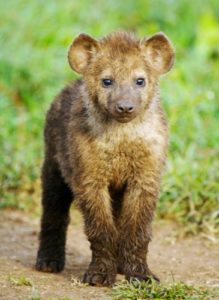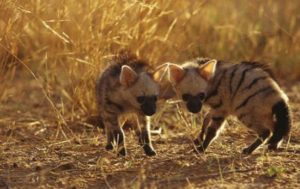Aardwolf Facts
Aardwolf Facts
(Proteles cristatus)
Despite being a member of the hyena family, aardwolves differ in many ways – one of them being their diet of termites.
![]()
Subspecies
Two: P.c.cristatus (S. Africa) and P.c.septentrionalis (E.Africa).
![]()
Statistics
Head-tail length: 0.85-1.05cm (2.8-3.4ft), weight: 8-10kg (17.6-22lb).
![]()
Physical Description
Like all members of the hyaenidae, aardwolves have longer front legs than the hind legs. The down-sloping body is accentuated by the crest-like back mane, which is most prominent on the neck and shoulders. Aardwolves can erect this crest if frightened or aggressive to make themselves appear larger. They have long yellow-white fur, which is paler on the throat and underparts. Vertical stripes run down the sides and diagonal stripes run across the fore- and hind-quarters.
![]()
Distribution
They inhabit East and southern Africa.
![]()
Habitat
Aardwolves are mainly found on open, grassy plains.
![]()
Diet
Unlike their close relatives, the hyenas, aardwolves are insectivores. The larger part of their diet is made up of termites (in particular, snouted harvester termites), although they also feed on maggots, grubs and other soft-bodied invertebrates. They will also very occasionally take small mammals, birds and carrion. Unlike most termite-feeding mammals, aardwolves do not dig into the nest, instead they simply lick up their prey. They may consume up to 200,000 snouted harvester termites in one night. Aardwolves lack the strong teeth and jaws exhibited by hyenas, the molars are small pegs – as an adaptation to their insect diet.
![]()
Behaviour
Aardwolves are solitary and nocturnal, and rest in burrows during the day. They are monogamous and each pair shares a territory of 1-4 square kilometres (the greater the availability of termites, the larger the territory). Despite the appearance of monogamy, during the breeding season, neighbouring males may sneak a mating with other females.
![]()
 Reproduction
Reproduction
2-4 cubs are born after a gestation period of 90 days. Males protect the cubs during the day while the female forages. They emerge from the den when they are 6-8 weeks old, and after 9-11 weeks, they forage with their mother. They are weaned after 16 weeks.
![]()
Conservation status
Aardwolves are not listed on the IUCN Red List 2000.
Didn’t even know there was a thing called an aardwolf
I wouldn’t mind a baby aardwolf
additional aardwolf facts:
The Aardwolf is small animal. It can reach 3 feet in length and up to 30 pounds in weight. Bushy tail is 7.9 to 11.8 inches long.
The body of an aardwolf is covered with two layers of dense fur that can be yellowish-white or reddish in color. Black stripes cover both sides of the body, including their limbs.
The Aardwolf has a mane that stretches from the head to the tail.
The Aardwolf raises its mane to appear bigger (and scarier) when it is threatened.
The Aardwolf has narrow muzzle and pointed ears. Its front legs are longer than hind legs.
The Aardwolf has 5 toes on front feet.
Unlike other hyenas, the aardwolf has poorly developed teeth. It has long and sticky tongue which is specialized for diet based on insects.
The Aardwolf’s diet consists almost exclusively of termites. It can eat up to 300 000 termites per night. Maggots and other invertebrates with soft bodies are occasionally consumed. The Aardwolf will eat small mammals, birds and carrion only when termites cannot be found.
The Aardwolf is a nocturnal creature (active during the night).
Besides humans, jackals are main enemies of aardwolves.
The Aardwolf is solitary and territorial animal. It occupies territory of 1 to 4 square miles. Boundaries of territory are marked with urine, dung and scent produced in anal gland.
The Aardwolf fiercely defends its territory (by fighting with other aardwolves).
The Aardwolf lives in underground burrows. Even though it can dig a hole in a ground using the claws, aardwolf prefers abandoned burrows of other animals such as aardvark and porcupine.
The Aardwolf is a silent animal that vocalizes only when it is threatened. Clucking and growling sounds can be heard occasionally.
Aardwolves are monogamous animals (one couple mate for a lifetime). Mating season takes place in the June and July.
Pregnancy in females lasts 90 days and ends with 2 to 4 cubs. Babies spend first month of their life hidden in a den.
Both parents take care of their young. Father guards the den against predators.
Young aardwolves drink mother’s milk during the first 3 or 4 months. After that period, they will join their parents in foraging for food.
Aardwolves will leave their family group at the age of one year to begin independent life.
The Aardwolf can survive 8 years in the wild and up to 15 years in captivity.
Aardwolves are weird.